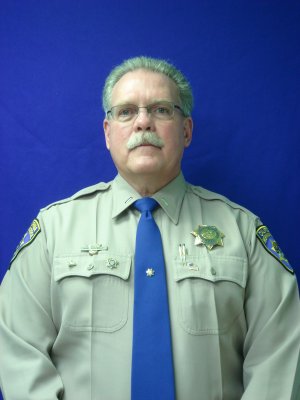- Elizabeth Larson
- Posted On
New interview center puts focus on safety, security of child victims

LAKEPORT – Along N. Brush Street sits a new, tidy little cottage dedicated to protecting children and assisting law enforcement in prosecuting child sexual abuse cases. {sidebar id=89}
The District Attorney's Office Victim-Witness Division celebrated the opening of its new children's Multi-Disciplinary Interview Center – or MDIC – at a gathering on Monday evening.
The new interview center already is considered the best facility of its kind in the state, according to Sam Laird, administrator of Victim-Witness.
But the real story behind the little building is the amount of community effort that went into making a good idea a better reality, with men and women – and even children – from all walks of life pitching in to offer supplies, labor and a lot of love to make it happen.
The sentiment that best sums the effort up is on a plaque that Rian Sommerfield, president of the Kelseyville Sunrise Rotary, presented to the center, with the names of everyone who participated engraved on it.
The plaque begins with the words, “This house was built with love.”
District Attorney Jon Hopkins told the group of community members and local leaders that victimized children need a comfortable, safe place where investigators can interview them with the least amount of trauma. The new building will serve that purpose, he said.
Last year, Hopkins and Laird began discussing the idea of building the center behind the Victim-Witness main building, in the location of an old shed that once had been a chicken coop.
For years, abused or sexually molested children who were part of a criminal investigation have been taken to a cramped little room – a converted broom closet, according to Laird – in the Lake County Courthouse, just up the hill from Victim-Witness.
There, they are interviewed by an investigator while, next door in the District Attorney's Elder Abuse unit, other investigators would crowd around a closed-circuit television in one corner of the room to monitor the interview.
It hasn't been an ideal situation, but the worst part of it, in Laird's opinion, was the walk the investigator and the child would take up the hill to the courthouse. Along the way, there was a risk the child could be seen by their abuser or others who might recognize the law enforcement officer with them.
"It was kinda like the Walk of Shame, walking them up there and down," Laird said.
Hopkins took the idea of an interview center to a department head meeting where Supervisor Rob Brown happened to be sitting in. When Brown heard about the idea, he gave it his enthusiastic support.
Both Hopkins and Laird credited Brown with helping give the project the overwhelming momentum that has carried it to completion after about eight months.
"Without Rob's involvement, none of this would even have been a blip on the radar screen," said Laird.

Brown told Lake County News at the event that he didn't ask anyone for a donation, but simply shared the plan with community members and groups, including the Kelseyville Sunrise Rotary, of which he is a member.
"Everybody said, 'What can we do?'" he said.
He suggested the desire by so many to participate was their way of reaching out to help children who have gone through the worst kinds of abuse imaginable.
Hopkins added that he thinks the effort touched people because the need for the center was explained from the perspective of a child who has been abused.
Many businesses came forward to make outright donations of materials or else offer them at cost, said Brown. Others donated their labor for such essentials as plumbing, electrical and flooring.
Brown said the effort got under way last October. He and Laird were on the site a lot, especially on weekends, with Brown using an excavator for site preparation. After that came the foundation and pouring cement.
Then the building went up. “We raised it like an Amish farmhouse,” said Laird.

Inmate trustee labor also played a big part, said Laird, with the men doing landscaping and irrigation, laying graving pathways and other important work that saved an estimated $40,000.
Public Services Director Kim Clymire's crews came over and added another finishing touch, an attractive wood fence that runs along the interview center's side that faces N. Brush Street, offering another barrier of safety, said Laird.
In all, Laird said he and Brown estimated that the center's total construction costs ranged between $200,000 and $250,000, with most of it donated by the community, outside of the work Public Services put in, and a District Attorney's Office allocation of $10,000 to pay for the center's audio and video equipment.
On Monday, in addition to presenting the plaque, Sommerfield also had the honor of handing over the building's keys to Laird, who responded with an enthusiastic, “Right on!”
Building has unique touches
The building's construction is unique. Its framing has about twice the amount of lumber one would normally see in such a project. Laird explained that is because it allowed them to hang more sheetrock in order to insulate it for privacy.
The building, which is about 560 square feet in size and painted a shade of green called “alligator pear,” has two age-appropriate interview rooms, which have double windows, again, to create more of a sound barrier. There's also an area outside of the interview rooms where a flat panel television screen hangs on a wall next to camera controls and audiovisual equipment for monitoring the interviews.
The Lakeport Women's Civic Club made a $10,000 donation to the project, which Brown said paid for a nearly quiet heating and cooling system.
There's another special touch, completed on Monday afternoon. Walk into the little building, and one of the walls – formerly painted white – is now fabulously alive with color and life in the form of Disney characters.
The mural was the concept of 17-year-old Steve Herdt II, a Kelseyville High Senior and son of Sheriff's Deputy Steve Herdt.
The talented young artist and his high school art teacher, Deb Ingalls, started work last week drawing a grid for the mural, which is Herdt's first. After about five days of painting, it was completed at 1 p.m. Monday afternoon, just in time for its debut.
Ingalls credited Herdt with the design – “I just worked for him,” she said.
Herdt's assignment was to make the room less sterile and more welcoming to a child.
“I started with Nemo,” he said of the popular fish cartoon character.
Herdt's mural depicts Nemo and other characters such as the Little Mermaid, Snow White and the creatures from “Monsters Inc.” circling around the word “Believe” in gold letters.

Center prepares for service
Laird said it will be about two weeks before the investigations will be fully transitioned over to the new center.
The team of investigators who will work primarily at the center includes District Attorney's Office Investigator Von Morshed, Det. Mike Curran of the Lake County Sheriff's Office, Crystal Martin of Victim-Witness and prosecutor Ed Borg, who is taking over the child sexual abuse prosecution caseload from fellow deputy district attorney John DeChaine.
DeChaine said he has worked such cases for four years, and it was time to move on to other casework. “It's good to get out of it so you don't get burned out,” he said, explaining the high level of stress that goes with the assignment.
Prosecuting cases involving children is a complex and delicate business, DeChaine explained. The District Attorney's Office is involved from the beginning, working to safeguard the child, making sure they have medical care and supervising interviews with the child by qualified forensics interviewers. Both Morshed and Curran hold such qualifications, as does Officer Jim Bell of Lakeport Police, he said.
“It's all designed to minimize the impact on the child,” he said.
For those adults involved in the law enforcement side, it can be an unforgettable experience. Laird told Lake County News in a previous interview that hearing a child recount being victimized is something that a person never forgets.
Is law enforcement seeing more cases involving children who are abused, sexually and otherwise? “I think there's a growth in reporting,” Hopkins said.
He believes the center and its new approach to investigating such cases also will encourage more people to come forward, knowing children will have an extra measure of safety and security in the process.
It also will assist, they believe, in putting together the best cases possible. “When a good case is put together and there's no wiggle room for them, a lot of them will plead guilty,” said Hopkins.
Careful investigations, said DeChaine, also are crucial to clearing the innocent and preventing someone from being wrongly accused.
That's important because of the stigma associated with sexual abuse. “Just an arrest for something like this can follow someone,” added Borg.
“This is going to assist us in weeding out the nonprovable cases from the provable,” said Hopkins.
There's another goal for everyone, too. It's that, someday, the little green building won't be needed for its original purpose anymore.
To see a photos of the MDIC being built and its finishing touches, visit the gallery page at http://lakeconews.com/component/option,com_wrapper/Itemid,37/.
E-mail Elizabeth Larson at This email address is being protected from spambots. You need JavaScript enabled to view it..
{mos_sb_discuss:2}

 How to resolve AdBlock issue?
How to resolve AdBlock issue? 










